Goya
In his autobiography, ‘A nose for money: How to make a million’, Douglas Collins describes how he combined £1,200 he received from his mother with funds from his partner Buzz Stephens, to establish Douglas Collins & Co., Ltd. in 1932. The new company started with a hair cream Collins had formulated but quickly expanded its range to include a number of toilet requisites normally used in barber shops.
Collins had also tried his hand at making a perfume that was to be sold through Jaeger shops, a venture Collins credits to Daisy Bembaron. She made handbags for Jaeger and had discussed the idea with Maurice M. Gilbert the managing director of Jaeger. The perfume Collins developed for Jaeger was a chype-oakmoss scent sold under the name Jaeger Bracken. It was well received and when Collins sold his business in 1935 he did so under the condition that he could resume making Jaeger Bracken if he started up again.
After a failed attempt to get into the green grocery business, Collins returned to making fragrances and began selling small phials of perfume each containing one-fourteenth of an ounce of scent each selling at for one shilling a phial. This was a much lower price than similar perfumes imported from France. Collins initially sold his perfumes under the name Fontaine but when he found that the name conflicted with an existing cosmetic brand he changed it to Goya. The Patent Office originally rejected his efforts to trademark the Goya name but he was eventually able to do this in 1941.
With Walter A. Barratt as a new partner, Collins then established D. R. Collins, Ltd. (capital £1000) in Russell Square, Brighton in 1937. However, he also registered a more fashionable postal address at 4 Whitehorse Street, Piccadilly, London to give his perfumes more cachet.
Goya did reasonable business but its fortunes improved dramatically in 1938 after it fulfilled an agreement with ‘Womans Journal’ to supply them with 200,000 samples of perfume to be given away as a circulation booster in their November issue. The price the magazine was prepared to pay meant that Collins lost money on each phial but he calculated that the advertising would be worth the loss.
Products
There were three perfumes in the initial Goya range – Studio, Gardenia, and No. 5. These were sold in three price ranges but I imagine most sales were for the more affordable one shilling phials.
Even your conscience can afford really expensive perfume in this new way! For Goya, creator of luxury scents for the world’s leading couturiers, offers you in attractive handbag phials costing only one shilling, exactly the same exclusive perfumes that he normally sells in two guinea flacons.
(Goya advertisement, 1939)

Above: 1939 Goya Studio, No. 5, and Gardenia.
In 1939, Collins added a face powder to the Goya range. It came in five shades but only one fragrance which Collins said he had done to ‘save retailers carrying large combinations of fragrances and shades’. It would also have made manufacturing the powder a good deal easier and, as Goya products were sold on consignment, it would also reduce returns and decrease the size of Goya’s inventory.

Above: 1939 Counter display for Goya Face Powder.
Goya Face Powder: “[L]asting—yet peculiarly light and delicate. It brings out the natural beauty in every skin, adds that final touch of loveliness.” Shades: Natural, Rachel. Peach, Nectarine, and Basque.
War
By the time war broke out in September, 1939, Goya was well established. However, Douglas Collins was drafted into the British navy in early 1940 so had to leave the management of the business to others for the duration of the war.
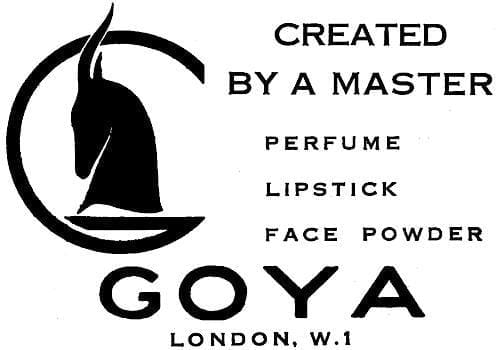
Above: 1944 Goya. Douglas Collins used the image of an gazelle’s head or a leaping gazelle on many early Goya lines.
In 1941, the company had to move its London address to 52 Brook Mews, Davis Street after the Piccadilly site was bombed. Despite this, Douglas Collins’ absence, and the raw material shortages caused by the war, Goya was able to introduced a number of new products during the war including: Bath Essences in Gardenia, Studio, and No. 5 fragrances (1940); two new perfumes, English Rose, and Heather (1941); and Goya Lipsticks (1941) in six shades – Seventeen, Cherry, Tomato, Basque, Cuba, and Burgundy.
D. R. Collins also added its Healing Antiseptic in 1942 to help protect injured skin from infection.
Post war
There were a number of changes in the way Goya operated in the years immediately following the end of the war. D. R. Collins, Ltd. moved its registered offices to 161 New Bond Street, London in 1945 and manufacturing was moved to Church Street, Amersham, Buckinghamshire in 1946. The site had once been a brewery but Collins renamed it Badminton Court. The following year, Goya, Ltd. (capital £100,000) was established as a separate company with registered offices at the New Bond Street address.
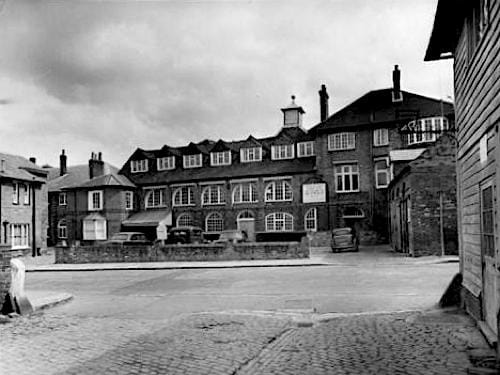
Above: Goya factory in Church Street, Amersham, Buckinghamshire.
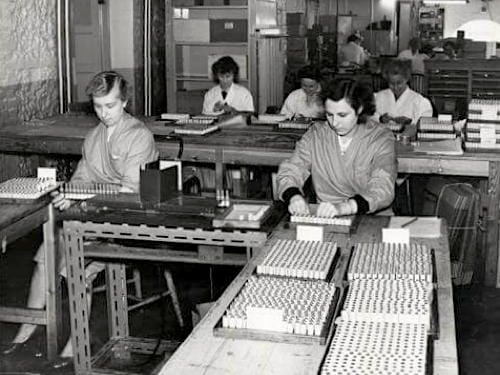
Above: Packing lipsticks into boxes in the Goya factory in Amersham. The girl on the left looks to be examining them for faults.
Expansion and merger
By 1950, Goya needed more manufacturing space and it constructed a new factory in Raans Road Amersham in 1951.
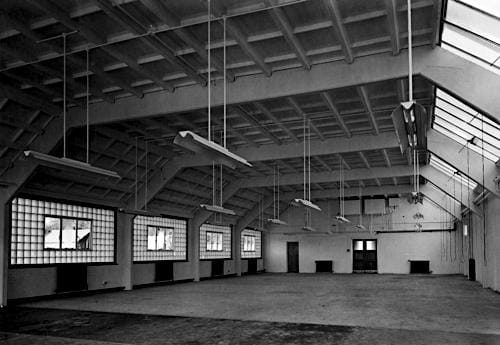
Above: Goya factory interior in Raans Road Amersham before it was occupied.
In 1952, Goya opened branch offices at 3 Rue Scribe, Paris and 745 Fifth Avenue, New York with the idea of exporting Goya products to both countries. I have been unable to determine how serious Goya was about this but it did allow them to add Paris and New York on the bottom of their advertisements.
In September, 1952, Goya then merged with J. C. & J. Field, Ltd., a company that could trace its origins back to 1642. Field made candles and soaps for most of its long history but had added toiletries in the 1920s and beauty aids in the 1930s.
According to one unverified report, it was Douglas Collins that initiated the merger. Field was bombed during the war and had received a large sum in war compensation damage but had done very little with it. Douglas Collins apparently knew this and arranged for Field to buy the entire capital of D. R. Collins, Ltd. providing he became Field’s managing director. He then used part of Field’s unused war compensation fund to expand Goya.
Under the terms of the amalgamation Field payed the minority shareholders of D. R. Collins, Ltd £110,000 in cash for their shares and issued 200,000 of Field’s 10 shilling shares to Douglas Collins for his 60% share along with £50,000 in cash. Collins was also made the managing director of Field for seven years.
Following the merger, Field moved their offices to Church Street, Amersham, opened a London office at 162 New Bond Street in 1953, and moved their manufacturing from Wimbledon to Amersham in 1954.
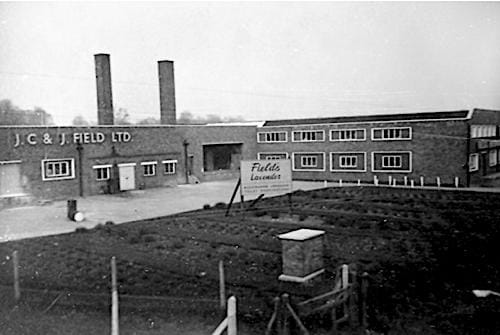
Above: 1956 J. C. & J. Field’s factory in Amersham. Note the window similarities with the Goya factory built in 1951.
Goya’s new factory in Raans Road and the subsequent merger did not stop production at Badminton Court.
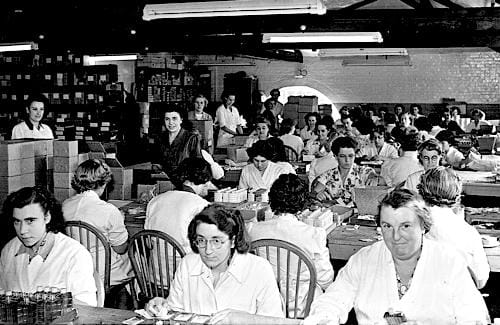
Above: Women labelling bottles at Badminton Court.
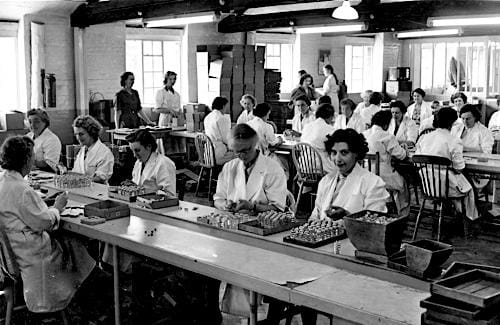
Above: Women labelling perfumes at Badminton Court.
In 1958, Griffith Hughes, Pty., Ltd. through their subsidiary, E. Griffiths Hughes, Ltd., purchased J. C. & J. Field, Ltd. for cash, selling D. R. Collins, Ltd., Jane Seymour, Ltd. (a Field subsidiary), and Goya, Ltd., to Douglas Collins, lending him £200,000 to help with the purchase. Two years later, Collins would resell all these companies to Reckitt & Colman for £600,000 cash.
Products
The production of Goya Bath Essences had ceased during the war but Goya reintroduced them in 1947. In 1949, it then added bath soaps in four fragrances – Rose Geranium, Gardenia, Blue Moss, and Yellow Gourse – each soap coming in a different colour for easy identification.
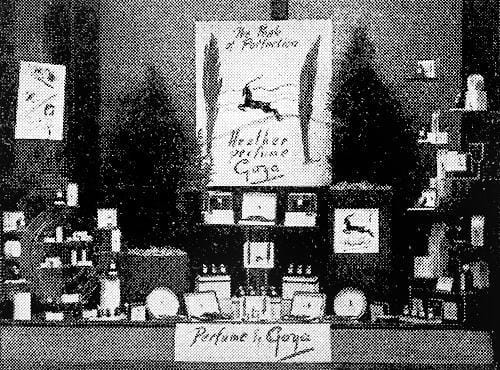
Above: 1947 Window display for Goya featuring Heather perfume.
Goya also introduced a number of new fragrances through to 1960 including Great Expectations (1948); Decision, and Vibration (1949); Pink Mimosa (1951); Goya 21 (1953); Black Rose (1955); and Remember (1959). A number of Goya perfumes were also developed as colognes in 1950.
Skin-care
In 1951, Goya added Rose Lotion, an all-purpose lotion that cold be used on the face, body and hands. In addition to it being used to cleanse, nourish and soothe the skin, Goya also claimed that it contained a sun-filter. This meant it could be used on the beach to promote an even tan without burning or used later to soothe and cool. Later advertising appears to have concentrated on its use as a hand lotion.
Rose Lotion: “[An] all-purpose lotion to cleanse, soothe, nourish from top to toe.
Rose Lotion was not included in Goya’s Liquid Beauty promotion of 1953. The cosmetics in the Liquid Beauty series consisted of Beauty Cleansing Cream, Beauty Tonic, Sleeping Beauty, Liquid Beauty, Antiseptic Lotion, Goya Cream Rouge, and a new Goya lipstick. The three new skin-care lines meant that Goya now had a cleanser, toner, and a night cream in its inventory.
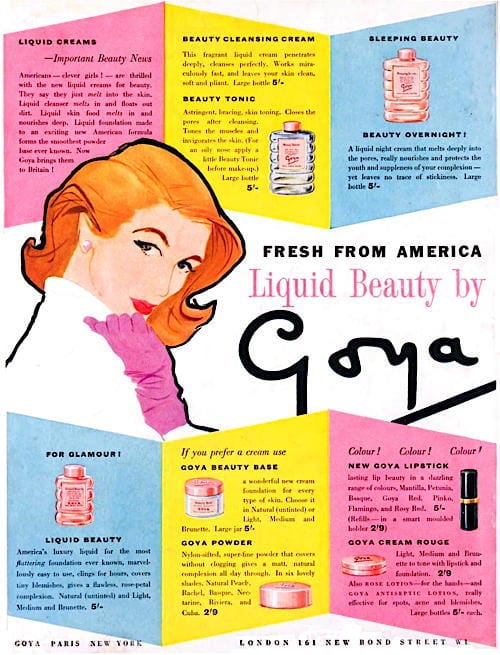
Above: 1953 Goya Liquid Beauty series.
Beauty Cleansing Cream: “This fragrant liquid cream penetrates deeply, cleanses perfectly. Works miraculously fast, and leaves your skin clean, soft and pliant.”
Beauty Tonic: “Astringent, bracing, skin toning. Closes the pores after cleansing. Tones the muscles and invigorates the skin. (For an oily nose apply a little Beauty Tonic before make-up).”
Sleeping Beauty: “A liquid night cream that melts deeply into the pores, really nourishes and protects the youth and suppleness of your complexion—yet leaves no trace of stickiness.”
Make-up
Goya started filling out its make-up range after the war and also expanded the shade ranges of exisiting make-up lines. It added a rouge in 1950 but Goya eye make-up and nail polish would not appear until the 1960s.
Foundations
In 1949, Goya added Beauty Base, its first foundation, a cream in one ‘natural’ shade and one fragrance. This was followed by Liquid Beauty in 1953, a liquid foundation in Natural (untinted) and three tinted shades as a part of Goya’ Liquid Beauty promotion. The formulation for Beauty Base was also improved in 1953 and housed in a new jar. It now came in the same shade range as Liquid Beauty, i.e., Natural, Light, Medium, and Brunette.
In 1958, Goya added Beauty All Day, a liquid emulsion in Natural and five tinted shades. It contained lanolin derivative and a humectant so would have functioned as a moisturising foundation. Goya updated Beauty Base at this time and it became an alternative to Beauty All Day for extra dry and sensitive skin types. Both products came in the same five shades and were made available in convenient to carry tubes.
Beauty Base: “A perfectly balanced foundation cream that suits every skin holds powder fast all day long. Tinted to match your skin . . . cunningly conceals tiny blemishes nourishes while it keeps your make-up matt and flawless all day through.” Shades: Natural (colourless) with Light, Medium, and Brunette added in 1953. In 1958 the shade range became Natural, Ivory, Rose, Honey Moon, Misty Pink, and Basque.
Liquid Beauty: “[The] glamorous liquid
foundation brings to every skin natural loveliness.” Shades: Natural, Light, Medium, and Brunette.
Beauty All Day: “[J]ust the thing to get the skin soft and smooth, in condition to stand up to harsh weather and cold winds.” Shades: Natural, Ivory, Rose, Honey Moon, Misty Pink, and Basque.
The Natural shade of these foundations could also have been used as day cream/lotion.
Face Powders
New shades added to Goya Face Powder started with Sun-Tan in 1946, with Rose Pink, and Cuba-Tan introduced in 1947. In 1952, the powder was reformulated and was rehoused in a new unspillable cardboard bowl. However, it now only came in six shades – Natural Peach, Rachel, Basque, Nectarine, Riviera, and Cuba. The powder box was changed again in 1953 as a part of the Goya Liquid Beauty promotion and now came in a pink plastic container.
In 1956, Goya added Beauty Puff, a cream-based powder in a choice of Cocktail or Shell compacts. Only the Shell case contained a mirror. Goya Face Powder was reformulated in 1957 and now came in the same shades as Beauty Puff.
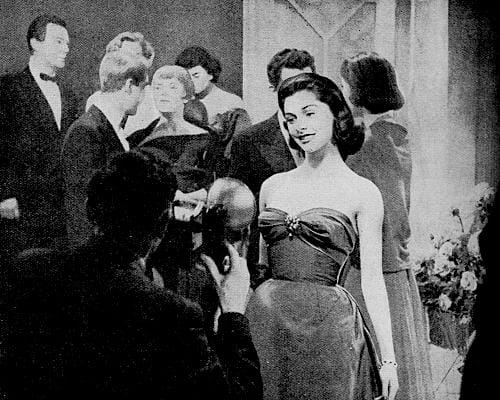
Above: 1957 British television advertisment for Goya Beauty Puff featuring the British actress Maureen Swanson [1932-2011]. She also appeared in print advertisements.
Beauty Puff: “The one complete make-up which cannot cake, streak, dry or change colour—ever. Caressingly it clings . . . flatters as it covers . . . yet is beautifully fine. Puff it on for a pearly look, a luminous glowing radiance. There it stays for loveliness all day.” Shades: Natural Peach, Basque, Nectarine, Riviera, Ochre, Ivory Rose, and Misty Pink, with Honey Moon added in 1957, and Roman Tan in 1959.
In 1959, Goya reformulated its Face powder and Beauty Puff with the ‘wonder-ingredient’ titania or titania anatase. This means the powder contained particles of titanium dioxide that were less than or equal to 10 nanometers. In addition to the reformulation, Goya repackaged Beauty Puff in a new shell compact design and added the Roman Tan shade to both the cream and loose powders.
Lipsticks
In 1947, Goya replaced its 11mm lipsticks with the larger 13mm-sized Lipstick Grandee. As well as being larger, the new lipstick was also cheaper. Goya also added an automatic, push-up lipstick in a black and gold case in the same year. Both of theses new lipsticks came in the same seven shades – Seventeen, Cuba, Burgundy, Cherry, Petunia, Trinidad, and Basque, with Capri added in 1948.
In 1949, Goya debuted its Thick & Thin lipsticks which combined a regular lipstick with a lip liner, both housed in refillable, ribbed, gold-toned, push-up case.
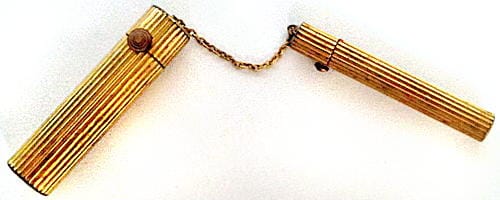
Above: Goya Thick & Thin Lipstick.
Thick & Thin: “Smooth, Smart, Glossy. The micro-integrated colours have new life and cover more evenly with a wonderful lasting film.” Shades: Seventeen, Cherry, Basque, Petunia, Goya Pink, Capri, and Mantilla.
Goya added a number of new lipstick case designs during the 1950s starting with a gilt, metallic, ribbed case in 1950 that had some similarities with the one developed for the Thick & Thin but was a twist-up rather than a push-up. All the current Goya shades – Seventeen, Cherry, Basque, Petunia, Goya Pink, Candy Pink, Capri, and Mantilla were available in the new case along with the new shade of Summer Red.
The Goya Liquid Beauty series, introduced in 1953, included a new lipstick in a black and gold twist-up case in seven shades – Mantilla, Petunia, Basque, Goya Red, Pinko, Flamingo, and Rosy Red – with Flamingo added in 1955.
Further case designs appeared when Goya launched its Kiss indelible lipstick in 1956. Initially housed in a plastic, pink and gold, twist-up Cocktail case this was replaced by three new designs in 1957 – a refillable Golden Case; a black and gold Theatre Case that could hold two Kiss lipsticks, a Kiss lipstick and a refill, or a Kiss lipstick and a phial of Goya perfume; and a pink and gold Swivel Stick case that could also be used as a refill for the other two cases. The reason for this change is unclear but may have been partly due to an update in the technical design of the refills.
Kiss Lipstick: “[T]he new lip colour formula which makes ordinary lipsticks old-fashioned! Like silk it glides on your lips—feels so smooth you don’t know it’s there! Eat, drink, smoke or smooch . . . the shimmering colour clings to you. Sets naturally . . . no blotting. Non dying. Non smearing.” Shades: Sweetie Pie, Poppet Pink, Flirting Fuchsia, Tru-Luv, Rosy Red, Forget-Me-Not, and Kiss Red. Other shades were Singing Pink (1957); Kiss Again, and Island Red (1958); and Kiss White, and Pink Tangerine (1959).
Kiss White added in 1959 was made with the same titania anatase used in the updated Goya Face Powder and Beauty Puff that I mentioned previously. It could be used under or over a conventional lipstick but Goya also suggested it could also be employed as an eyeshadow either by itself or in combination with those that were coloured.
Goya reformulated its lipsticks once more in 1960 and added a new shade called Rosebuds.
Rouge
In 1950, Goya began selling a cream rouge to be worn over Beauty Base but before powdering. It came in three shades – Candy Pink, to wear with Pink, Candy Pink, and Seventeen lipsticks; Basque, to coordinate with Basque, and Capri lipsticks; and Cherry, to match with Cherry, Petunia, and Mantilla lipsticks.
Men’s range
In 1951, Goya launched its Corvette range of toiletries for men and set up a new men’s division to handle it. The range consisted of Corvette Shaving Stick, Shaving Bowl, Lather Shaving Cream, Brushless Shaving Cream, Hair Cream, Liquid Brilliantine, Solid Brilliantine, Invisible Talc, and After-Shave Lotion. Corvette Cologne, Toilet Soap, and Pre-Electric Shave Lotion were added in 1960 and the entire line was repackaged the following year.
Collins apparently selected the name because he had served on a corvette during the Second World War. However, rather than the modern vessel, the products were badged with a picture of corvette from the sailing era taken from a painting by the marine artist Leslie Arthur Wilcox [1904-1982]. A promotion for the new range was organised with the film ‘Captain Horatio Hornblower’ which was conveniently released by Warner Brothers in 1951.
Many of the products in the range must have been similar to those produced by Douglas Collins when he owned Douglas Collins & Co in the 1930s. I also note that the design for Corvette Shaving Bowl looks very similar to the unspillable face powder case Goya would add the following year that I noted earlier.
Goya added a new masculine fragrance called Cedar Wood in 1958 and then used it to create a second men’s range. This began with Cedar Wood Cream Shave, Brushless Shave, Talc, Tonic Hair Dressing, and After Shave (1959); followed by Cedar Wood Shaving Bowl (1961); Cedar Wood After-Shave Lotion (1962); Cedar Wood Hair Cream (1964); Cedar Wood Aerosol Hairdressing, and Deodorant for Men (1965); Cedar Wood Aerosol After-Shave (1955); Cedar Wood Bowl, and Lather Shave (1967); and Cedar Wood Deodorant Spray (1968).
Care Laboratories
In 1955, Goya added Sombrero suntan cream in a tube. The formulation included Solprotex, a proprietary ingredient that was said to act as a sunscreen. In 1957, Goya then introduced Check Stick an antiperspirant and deodorant stick. These products were initially sold under the Goya name but were passed to Care Laboratories, Ltd. in 1959, a new subsidiary founded in 1958 (capital £100) following the D. R. Collins buy back earlier in the year. Care had offices at 161 New Bond Street, London, and its products included Care Hand Cream, originally a Jane Seymour line, which was, I presume, where it got its name.
Later products added to Care included Check Roll-On (1959); Check Cream Deodorant, Check Spray Deodorant, and Sombrero Spray (1960); and Check Family Deodorant Spray, an aerosol (1967).
1960s
By the end of the 1950s, Goya was operating in South Africa, Australia, New Zealand, Sweden, Canada, Ceylon, Rhodesia, and the British West Indies as well as the United Kingdom. As mentioned earlier, Reckitt & Colman, Ltd. bought D. R. Collins, Ltd. in 1960, which meant that it now owned Goya, Care Laboratories, and Jane Seymour.
Reckitt & Colman was formed in 1938 from the merger of two old British brands – J. & J. Colman formed in 1854, and Reckitt and Sons, Ltd. which could trace its origins back to 1840.
Products
Goya continued to introduce new fragrances during the 1960s including Love Affair (1960), Entice (1962), Frenzy (1964), Wild Silk (1965), Timeless (1966), Piquant (1967). It also added spray colognes (1960), perfumed Spray Set hair sprays (1961), cream perfumes, and eau de toilettes (1966)
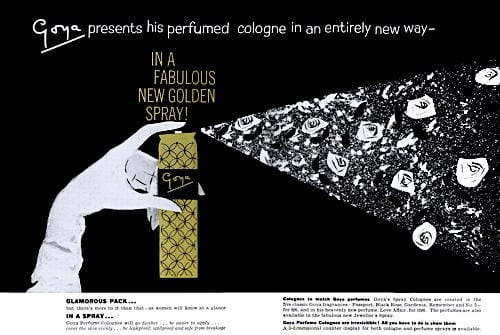
Above: 1960 Trade advertisement for Goya Golden Spray perfumed colognes.
Goya also added a Perfumed Hand Lotion (1960) in Passport, Remember, Black Rose, Gardenia, and No. 5, as well as Foamy Hand Cream (1966) in an aerosol can in Timeless, Wild Silk, Frenzy, Love Affair, Gardenia, No. 5, and Black rRose fragrances.
Make-up
One of the first Goya releases after it was purchased by Reckitt & Colman were new Golden Touch Beauty Puff compacts (1960).
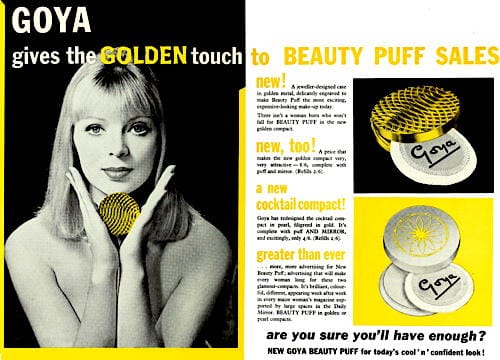
Above: 1960 Trade advertisement for Golden Touch Beauty Puff.
The golden theme was followed in other lines including the previously mentioned Goya Golden Spray perfumed colognes and the Golden Girl make-up range which debuted in 1963. Golden Girl rmake-up included Goya’s first nail polish and first eye make-up range.
Golden Girl
The Goya Golden Girl range looks to have taken its lead from the Wonder cosmetics that D. R. Collins had developed for Jane Seymour between 1958 and 1960 while it was owned by Douglas Collins.
See also: Jane Seymour
The Golden Girl range debuted with Golden Girl Face Powder, and Beauty Puff in the same shades; Golden Girl Lipstick (refillable), and Nail Colour in complementary shades; Golden Girl Mousse, and Fluid Foundations in identical shades; and Golden Girl Cleansing Cold Cream.
Packaging for the range included a ribbon motif as a decorative element on the labels of jars, the tops of the Golden Girl Beauty Puffs and on the handles of the Goya Nail Colour bottles. An exception to this was the Golden Girl Lipstick with came in a Golden Case, although later Golden Girl lipsticks conformed to the new design.
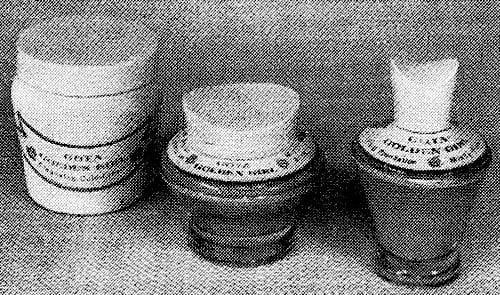
Above: 1953 Golden Girl Cleansing Cold Cream, Mousse, and Fluid Foundation with labels designed to look like ribbons.
The new foundations emphasised their moisturising benefits with women selecting the version best suited to their particular skin type. The new face powders applied over these foundations were said to have been reformulated to work with them. Goya also added Crystal Pearl, a green powder that could be applied under powder, to give the face a translucent look or to hide redness and/or broken veins.
Golden Girl Liquid Foundation: “A creamy moisturising base for normal and dry skins.” Shades: Creamy Opal, Misty Pink, Honey Mist, and Sun Ripple.
Golden Girl Mouse Foundation: “[A] moisturising liquid make-up for normal and oily skins.” Shades: Creamy Opal, Misty Pink, Honey Mist, and Sun Ripple.
Golden Girl Beauty Puff: “Covers perfectly, yet still allows air to reach your skin. Self-freshening because your skin can breathe! Powder spun in a unique way, blended with a special moisturising cream. Keeps your skin soft, smooth. And keeps a fresh clear look hours longer!” Shades: Creamy Opal, Fair Camellia, Misty Pink, Peach Chiffon, Honey Mist, Sun Ripple. and Golden Goddess, with Tawny Mist added in 1966.
Golden Girl Lipstick: “[W]ith constant colour, the first lipstick in which surface colour and base colour are perfectly matched. … [T]he colour cannot change on your lips . . . stays true hour after hour.&rdqou; Shades: Pink from Peru, Siamese, Fiesta, Chinese, Peach Topaz, Beachcomber, Burmese, Toreador Pink, Tangerine Rose, Bronze Venus, Manhattan Red, and Red Vino. New shades: Play-it-Pink (1964); Smouldering Gold, and Smouldering Pink (1965); and Softly Rose, Softly Apricot, and Softly Honey (1966).
Golden Girl Nail Colour: “Perfect colour to team with Golden Girl Lipsticks.” Shades: Pink from Peru, Peach Topaz, Siamese Pink, Burmese Coral, Fiesta Pink and Tangerine Rose shades as well as Shimmering Pearl shades in Silver, Coral, Pink, and Scarlet. New shades: Play-it-Pink (1964).
In 1964, Goya extended the Golden Girl range adding a moisturiser, a stick eyeshadow, two mascaras and an eye pencil. Unfortunately, I don’ t have shade ranges for the eye make-up.
Golden Girl Magic Moisturiser: “This pearly green liquid contains Aqualon. a unique humectant, which helps retain the skin’s natural moisture.”
Golden Girl Creamy Compact Mascara: “Long luscious lashes in a moment! New, soft, cream-blended formula completely does away with stickiness and spikiness.”
Golden Girl Brush-matic Mascara: “Twirl on rich, lasting colour with a spiral brush. Unique formulas builds lashes to look longer and thicker.”
Golden Girl Creamy Eye Shadow-matic: “[E]ye shadow that flows on! No smudging. No streaking. A perfect reult every time. Extra creamy, too, to protect the precious skin around your eyes.”
Golden Girl Automatic Self-sharpening Eye Pencil: “Super soft. Soft enough to double as an eye liner—never stretches the sensitive skin around your eyes”
Later additions included Brush and Glow (1965) a compact powder blush in three shades – Golden Blush, Rose Blush and Peach Blush; and Golden Girl Lipshimmer (1965). Lipshimmer, which contained natural pearl, could be applied under or over other Golden Girl lipsticks to alter their colour and/or give them a soft, translucent finish.
By 1967, Goya appears to have given up on the Golden Girl range as two later additions – Lipsheen Lipsticks and Superlucent Beauty do not appear to have been included in it.
Lipsheens (1967) were creamy, gloss lipsticks in Lipsheen Peach, Lipsheen Pink, Lipsheen Apricot, Lipsheen Honey, Lipsheen Red, and Lipsheen Rose shades with Lipsheen Sand, Lipsheen Spice, and Lipsheen Amber added in 1968.
Superlucent Beauty (1967), was a new foundation available in tubes and as an aerosol in Natural Ivory, Creamy Blush, Muted Peach, Magnolia Rose, Hint of Honey, and Golden Dawn shades.
Also in 1967, Goya introduced its Cosmetrics make-up series which fit into a plastic Beauty Maker case which had space for four different make-up products that women could select from a counter dispenser and change as they desired.
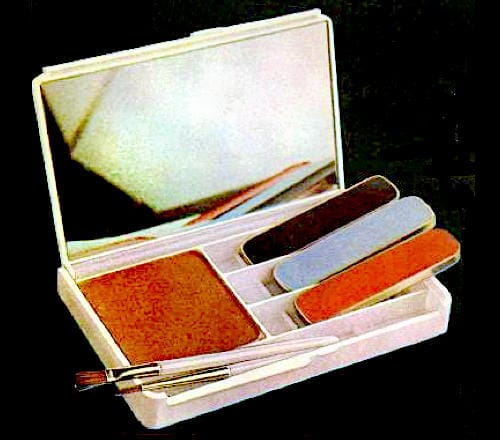
Above: Goya Cosmetric Beauty Case with inserts and brushes. A square puff would have fitted over the cream foundation on the left.
Make-up available for the Beauty Case included cream foundation, blush powder, sheer finishing powder, cake eyeliner, powder eyeshadow, eyelight powder, cake mascara and palette lipstick. There was also space in the case for a square puffer and a brush and the lid had an inbuilt mirror. I imagine that some lines like the cake mascara and palette lipstick would have had limited sales. The entire range appears to have had a very limited life as lit came just before Goya was sold once more.
Later developments
Douglas Collins had interests that lay outside of Goya. He was a member of the National Film Finance Corporation from 1955 to 1961, and was the chairman of British Lions Film between 1957 and 1961. In 1964 he bought a half share in Sutton and Sons, Ltd., founded in Reading in 1806, and become its majority shareholder in 1966.
In 1968, Reckitt & Colman sold D. R. Collins, Ltd. back to Douglas Collins in 1968 for £800,000 excluding the rights to trademarks outside of the United Kingdom, the Common Market, America and Canada. Three quarters of the shares were owned by Sutton and Sons with the other quarter being held by Christopher Collins, Douglas Collin’s son. The sale included Goya, Ltd., Jane Seymour, Ltd., and Care Laboratories, Ltd. but Jane Seymour was sold off the Rimmel International, Ltd. in 1969.
Following the buyback, Goya discontinued the production of its cosmetic lines and concentrated on making perfumes and toiletries repackaged in contemporary designs.
One of the most memorable Gota lines from the 1970s was the Aqua Manda range. Goya had previously introduced an Aqua Manda Toilet Water back in 1946 but the later version appears to have been reformulated by Christopher Collins.
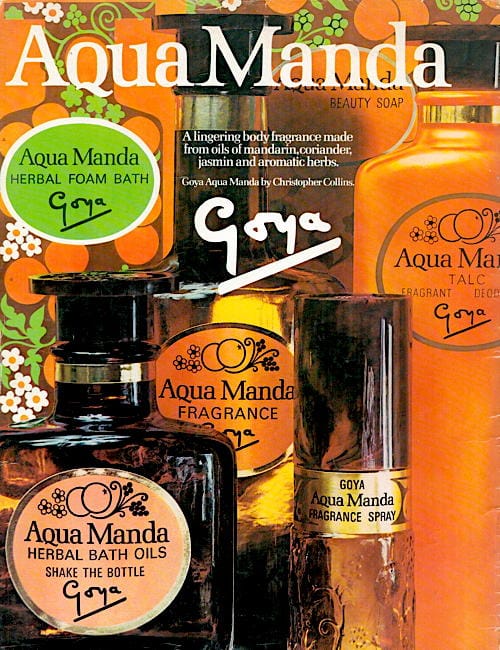
Above: 1972 Aqua Manda.
Goya continued on for many years under Christoper Collins including a number of years after D. R. Collins was sold to Imperial Chemical Industries, Ltd (ICI) in 1975. The building in Badminton Court was eventually sold off but still stands today. However, what you see is not the original edifice. A significant proportion of it was demolished and rebuilt in 1986. Fortunately much of the repurposing used existing materials.
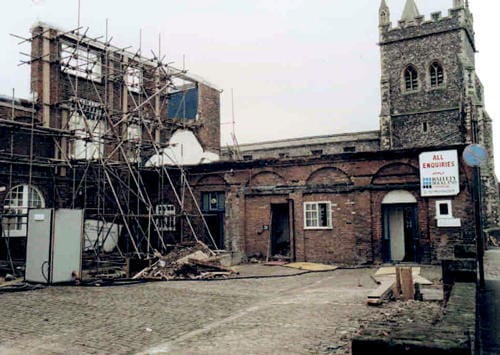
Above: 1986 Rebuilding work at the old Goya offices and factory in Badminton Court.
In 1984, Goya was sold to Beauty International Fragrances, Ltd. which became part of the European Brands Group in 1988. As far as I can tell, Goya fragrances are still being sold by Beauty International to this day.
Timeline
| 1937 | D. R. Collins, Ltd. founded in Brighton with registered office in Piccadilly, London. |
| 1939 | New Products: Goya Face Powder. |
| 1941 | New Products: Goya Lipsticks. |
| 1942 | New Products: Collins Healing Antiseptic. |
| 1945 | Registered office moved to 161 New Bond Street, London. |
| 1946 | D. R. Collins, Ltd. moves to Amersham. |
| 1947 | Goya, Ltd. founded. New Products: Goya Automatic Lipstick; and Grandee Lipstick. |
| 1949 | New Products: Thick & Thin Lipsticks; and Beauty Base. |
| 1950 | New Products: Goya Cream Rouge. |
| 1951 | Factory constructed in Raans Road, Amersham. New Products: Rose Lotion. |
| 1952 | D. R. Collins merges with J. C. & J. Field. Branch offices opened in Paris and New York. |
| 1953 | New Products: Liquid Beauty; Beauty Tonic; and Antiseptic Lotion. |
| 1955 | New Products: Sombrero Sun Tan Cream. |
| 1956 | Australian division merges with James Hare & Co. |
| 1957 | New Products: Beauty Puff; and Check Stick. |
| 1958 | Griffith Hughes buys J. C. & J. Field and sells D. R. Collins,Jane Seymour and Goya, back to Douglas Collins. Care Laboratories, Ltd. established. New Products: Beauty Plus; and Beauty all Day. |
| 1960 | Reckitt & Colman, Ltd. buys D. R. Collins, Ltd. including Goya, Jane Seymour, and Care Laboratories. New Products: Perfumed Hand Lotion. |
| 1961 | New Products: Perfumed Cleansing Pads; and Spray Set. |
| 1963 | New Products: Golden Girl range; and Crystal Pearl. |
| 1964 | New Products: Golden Girl Magic Moisturiser; Golden Girl Eye Make-up; and Dry Deodorant. |
| 1965 | New Products: Blush and Glow; Lipshimmer Lipsticks; and Spray Deodorant. |
| 1967 | New Products: Lipsheen Lipsticks; and Superlucent Beauty. |
| 1968 | Reckitt & Colman sells D. R. Collins (Goya, Jane Seymour, and Care Laboratories) to Douglas and Christopher Collins. |
| 1969 | Jane Seymour sold to Rimmel International, Ltd. |
| 1975 | Goya sold to Imperial Chemical Industries (ICI). |
| 1984 | Goya sold to Beauty International Fragrances. |
| 1985 | Badminton Court shut down. |
| 1988 | Beauty International Fragrances bought by the European Brands Group. |
First Posted: 11th October 2024
Sources
The chemist and druggist. (1859-) London: Morgan Brothers.
Collins, D. R. (1963) A nose for money: How to make a million. London: Michael Joseph.
Goya cosmetics and perfumes. Amersham Museum. Retrieved 26th June, 2024 from https://amershammuseum.org/history/trades-industries/goya/
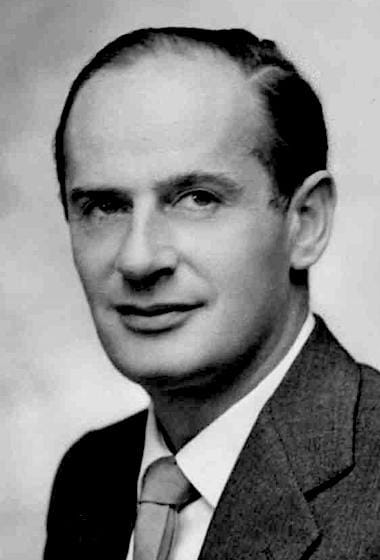
Douglas Raymond Collins [1912-1972].
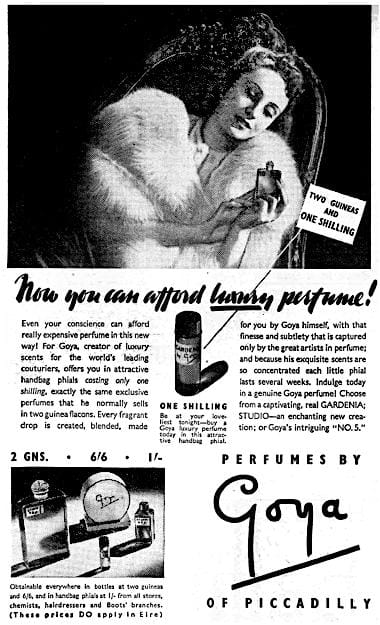
1939 Goya Perfumes.
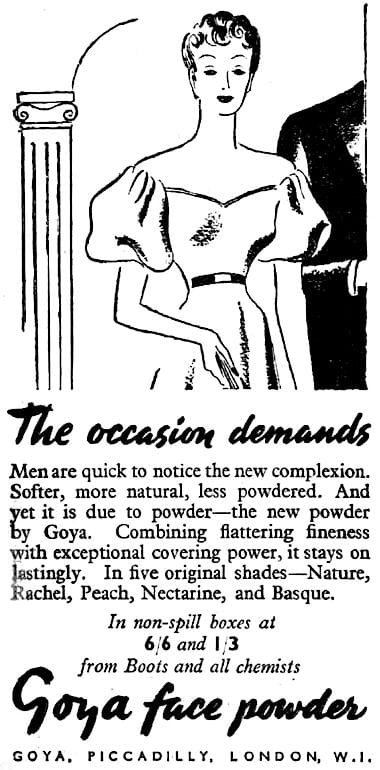
1939 Goya Face Powder.

1940 Goya Bath Essence.
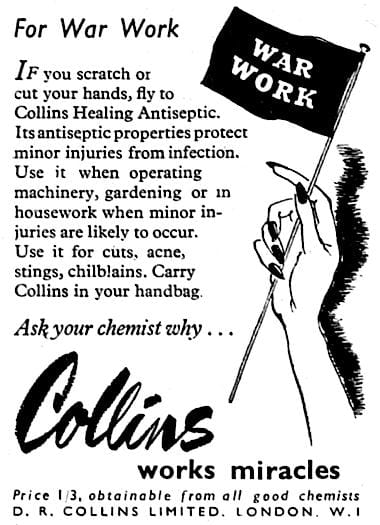
1942 Collins Healing Antiseptic.

1942 Goya Face Powder, Lipstick and Perfumes.
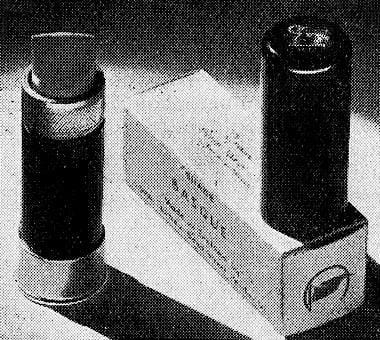
1948 Goya Lipstick Grandee.
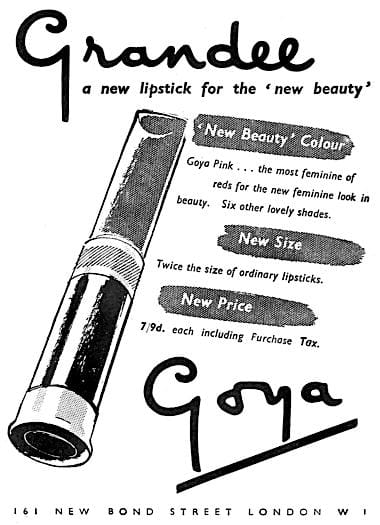
1948 Goya Lipstick Grandee.
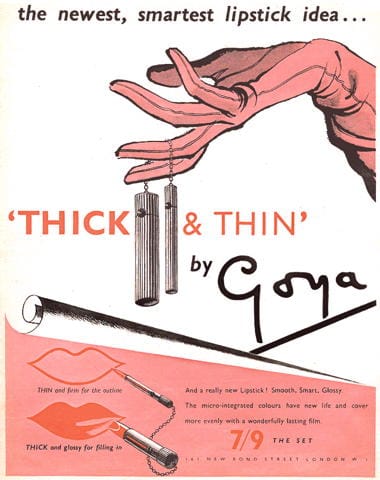
1949 Goya Thick & Thin Lipsticks.

1949 Goya soaps. Goya stopped making soaps in 1960.
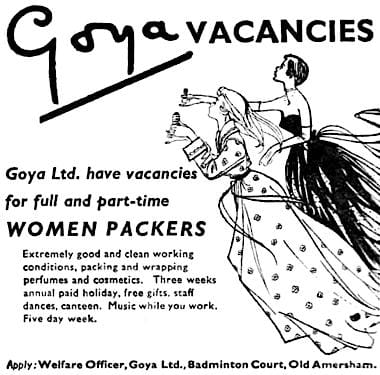
1950 Goya advertisement for women packers. Staffing was a major problem for Goya as a lot of work was done by hand.
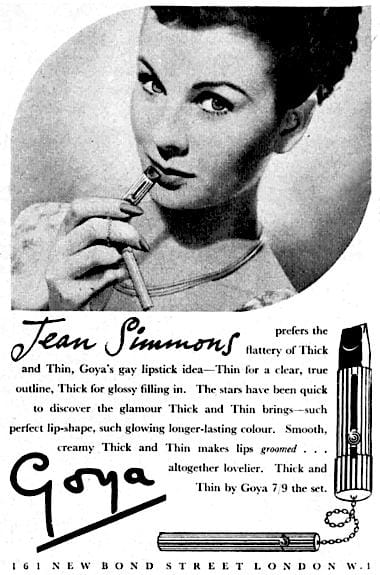
1950 Goya Thick & Thin Lipsticks.
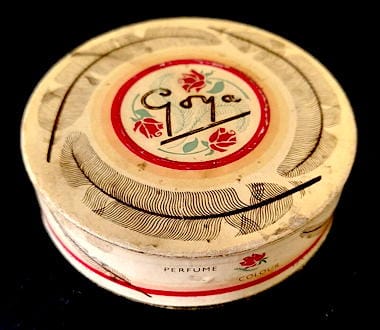
Goya Face Powder.
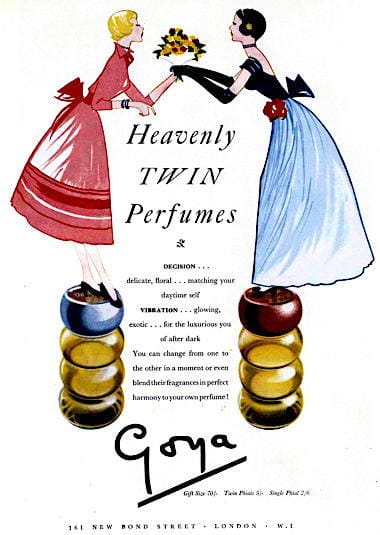
1949 Goya Decision and Vibration p erfumes.
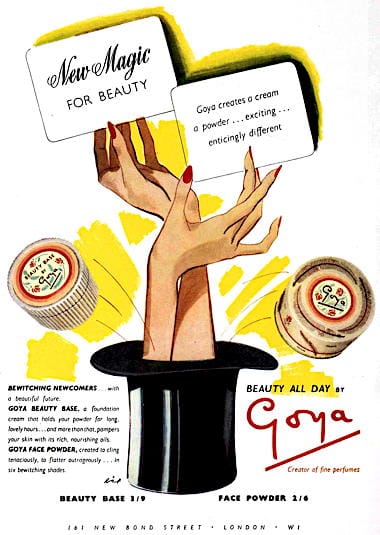
1950 Goya Beauty Base, and Face Powder.
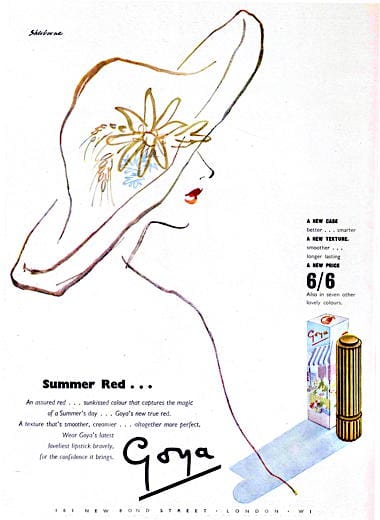
1950 Goya Summer Red.

1951 Goya Corvette.
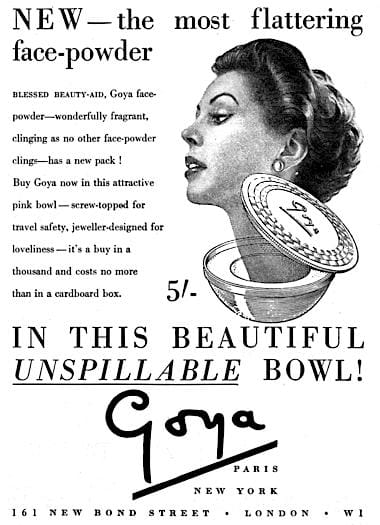
1952 Goya Face Powder in unspillable bowl. The container had a built-in sifter that separated the included puff from the powder.
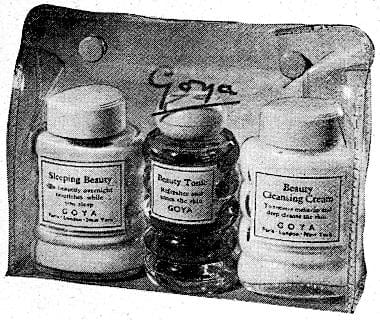
1953 Goya Travel Trio – Sleeping Beauty, Beauty Tonic, and Beauty Cleansing Cream in a plastic carry case.
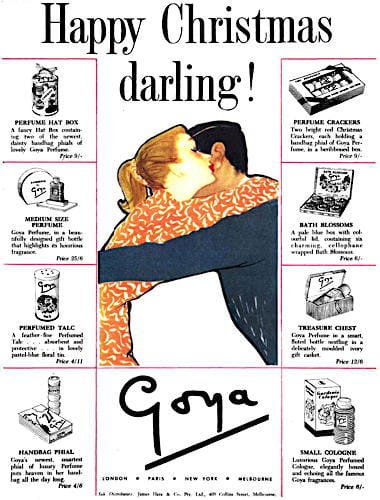
1953 Goya Christmas suggestions.
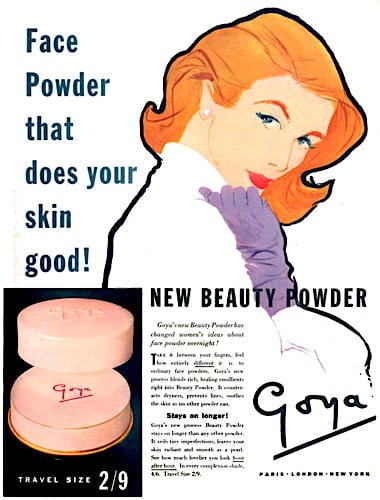
1954 Goya Face Powder in pink plastic case.
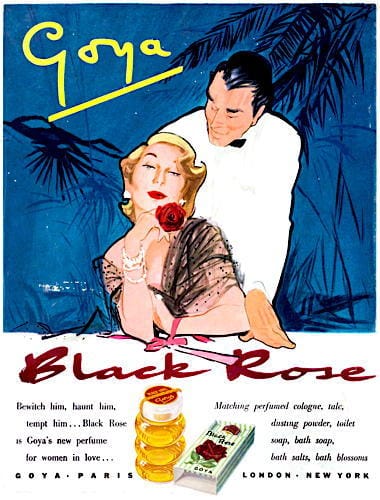
1955 Goya Black Rose.
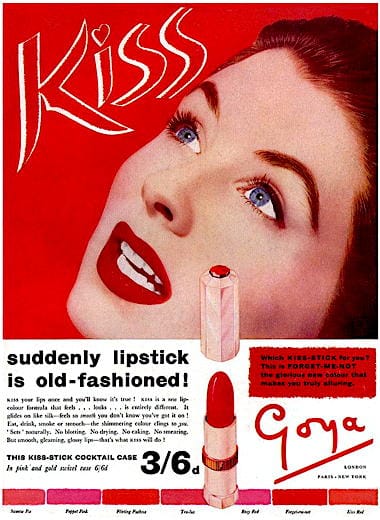
1956 Gala Kiss Lipstick.
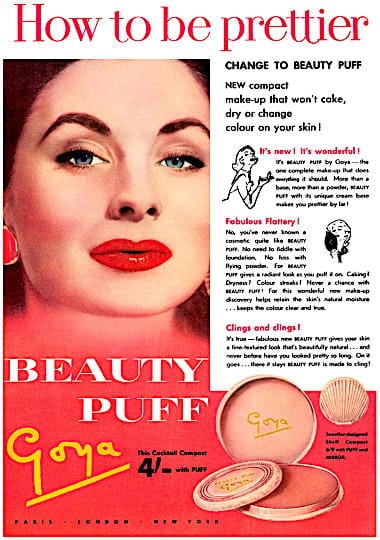
1956 Goya Beauty Puff.
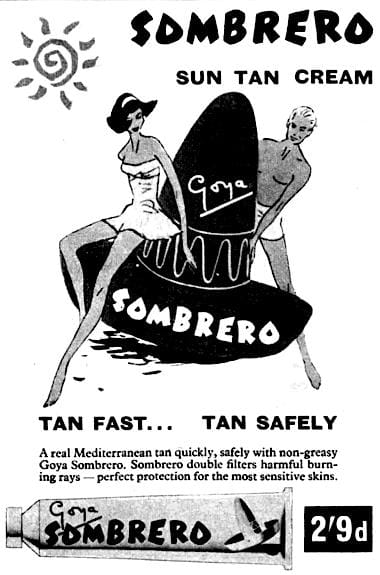
1957 Goya Sombrero.
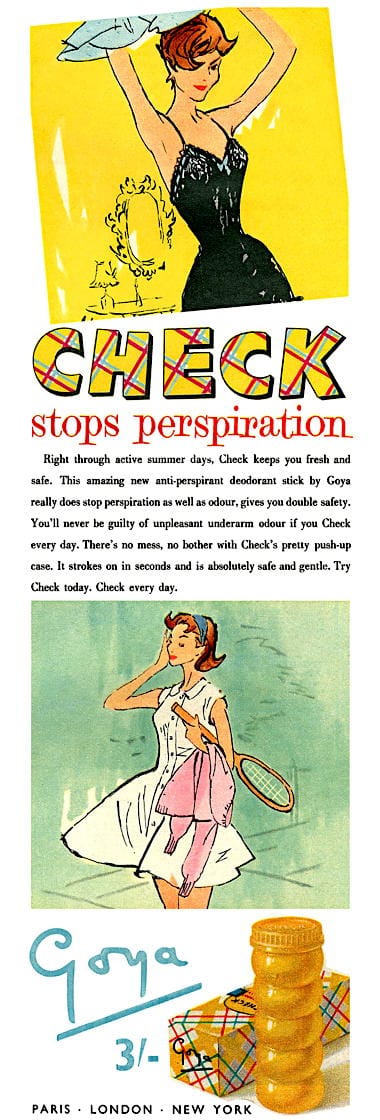
1957 Goya Check antiperspirant deodorant stick.

1958 Goya Island Red.
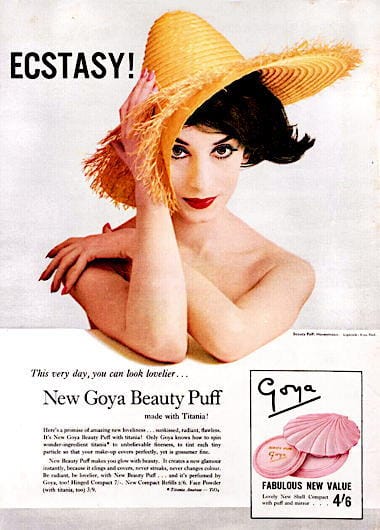
1959 Goya Beauty Puff in new case design.
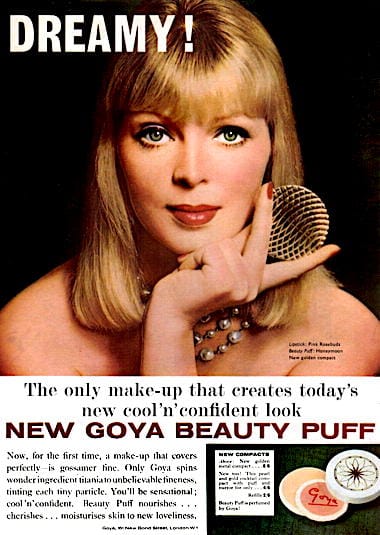
1960 Goya Beauty Puff in Golden Metal Compact, and Gold and Pearl Cocktail Compacts.
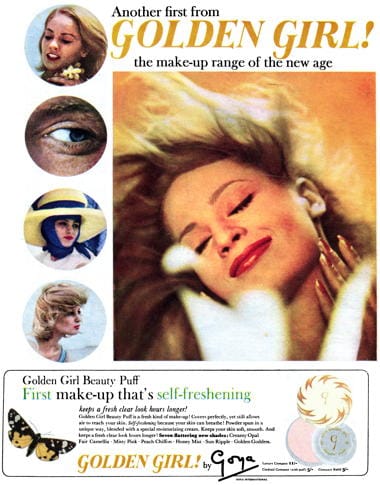
1963 Goya Golden Girl Beauty Puff.
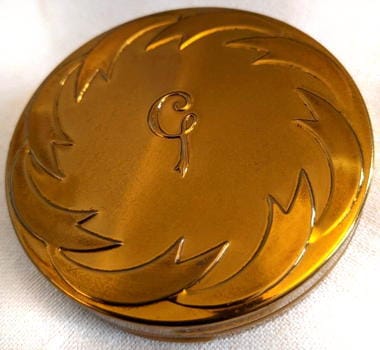
Metal version of Golden Girl Beauty Puff with ribbon decoration.
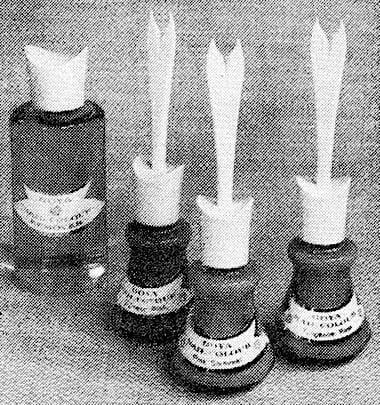
1963 Goya Golden Girl Oily Polish Remover, and Nail Colour with ribbon handles.
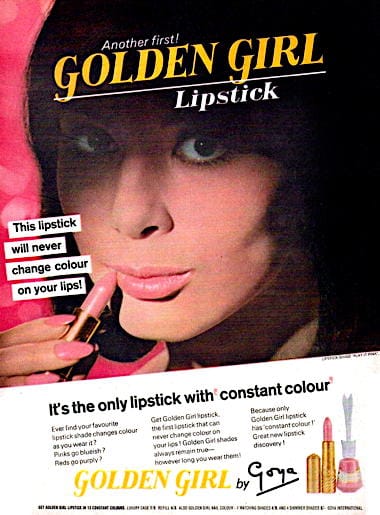
1964 Goya Golden Girl Lipstick.
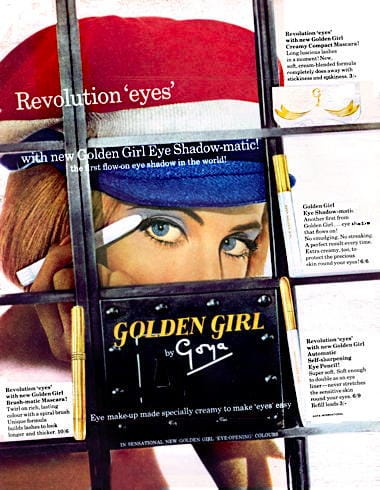
1964 Goya Golden Girl Eye Make-up.
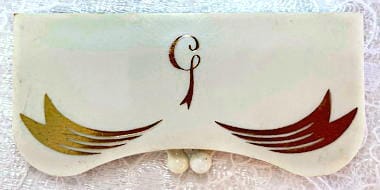
Goya Golden Girl Creamy Compact Mascara.
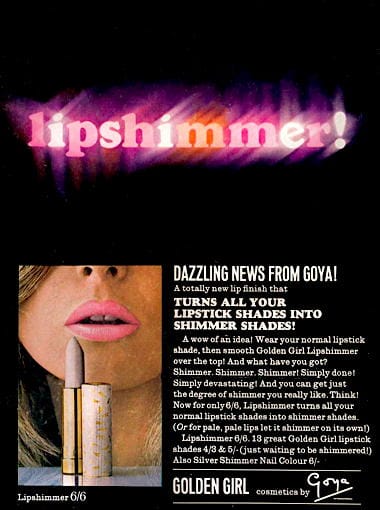
1965 Goya Lipshimmer.
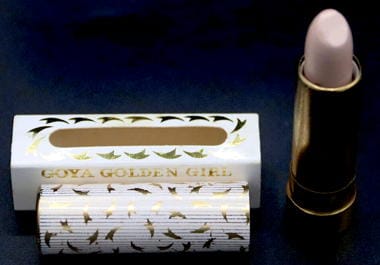
Golden Girl Lipshimmer in ribbon case.
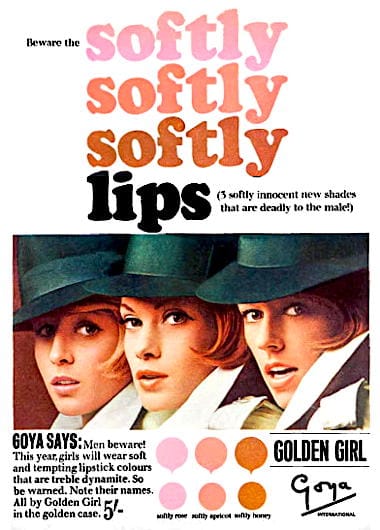
1966 Goya Soflty shades of Golden Girl Lipstick.
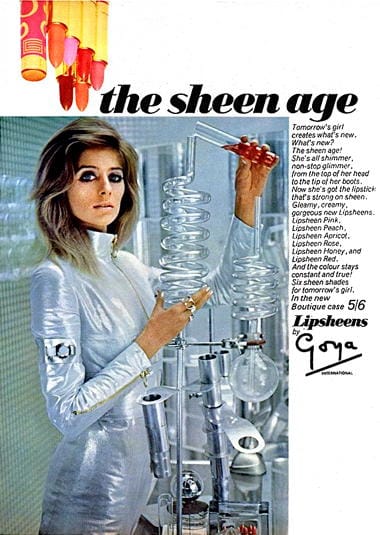
1967 Goya Lipsheen Lipsticks.
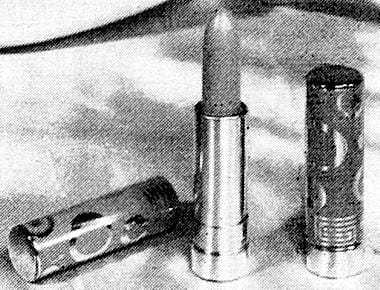
1967 Goya Lipsheen Lipstick.
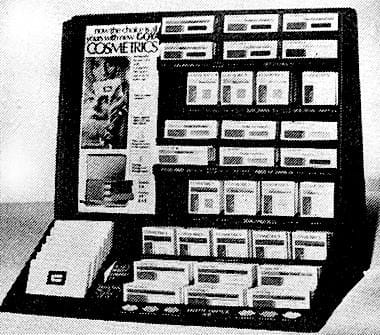
1967 Goya Cosmetrics display case.
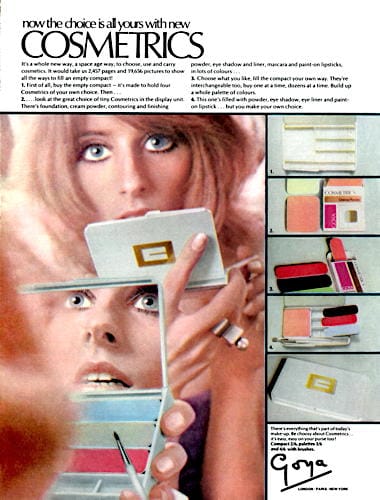
1967 Goya Cosmetrics.
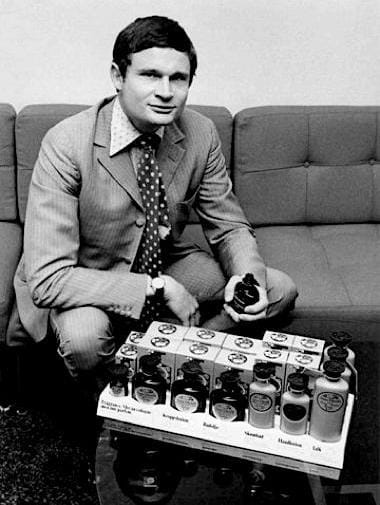
Christopher Collins [b.1939] with Aqua Munda.
